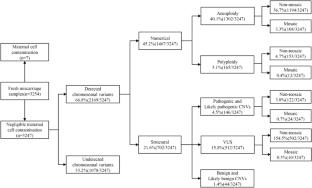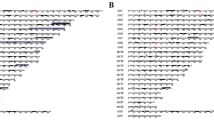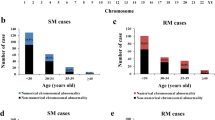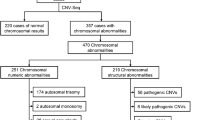Abstract
Purpose
This study aimed to investigate the correlation between chromosomal abnormalities in spontaneous abortion with clinical features and seek copy number variations (CNVs) and genes that might be connected to spontaneous abortion.
Methods
Over 7 years, we used CNV-seq and STR analysis to study POCs, comparing chromosomal abnormalities with clinical features and identifying critical CNVs and genes associated with spontaneous abortion.
Results
Total chromosomal variants in the POCs were identified in 66.8% (2169/3247) of all cases, which included 45.2% (1467/3247) numerical abnormalities and 21.6% (702/3247) copy number variants (CNVs). Chromosome number abnormalities, especially aneuploidy abnormalities, were more pronounced in the group of mothers aged ≥ 35 years, the early miscarriage group, and the chorionic villi group. We further analyzed 212 pathogenic and likely pathogenic CNVs in 146 POCs as well as identified 8 statistically significant SORs through comparison with both a healthy population and a group of non-spontaneously aborted fetuses. Our analysis suggests that these CNVs may play a crucial role in spontaneous abortion. Furthermore, by utilizing the RVIS score and MGI database, we identified 86 genes associated with spontaneous abortion, with particular emphasis on PARP6, ISLR, ULK3, FGFRL1, TBC1D14, SCRIB, and PLEC.
Conclusion
We found variability in chromosomal abnormalities across clinical features, identifying eight crucial copy number variations (CNVs) and multiple key genes that may be linked to spontaneous abortion. This research enhances the comprehension of genetic factors contributing to spontaneous abortion.






Similar content being viewed by others
Data availability
The datasets generated during and/or analyzed during the current study are available from the corresponding author upon reasonable request.
References
Luise C, Jermy K, May C, et al. Outcome of expectant management of spontaneous first trimester miscarriage: observational study. BMJ (Clin Res Ed). 2002;324(7342):873–5.
Quenby S, Gallos ID, Dhillon-Smith RK, et al. Miscarriage matters: the epidemiological, physical, psychological, and economic costs of early pregnancy loss. Lancet (London, England). 2021;397(10285):1658–67.
Kersting A, Wagner B. Complicated grief after perinatal loss. Dialogues Clin Neurosci. 2012;14(2):187–94.
Cubo AM, Soto ZM, Haro-Pérez A, et al. Medical versus surgical treatment of first trimester spontaneous abortion: a cost-minimization analysis. PLoS One. 2019;14(1):e0210449.
Hardy K, Hardy PJ, Jacobs PA, et al. Temporal changes in chromosome abnormalities in human spontaneous abortions: results of 40 years of analysis. Am J Med Genet A. 2016;170(10):2671–80.
Zhu XZ, Deng ZM, Dai FF, et al. The impact of early pregnancy metabolic disorders on pregnancy outcome and the specific mechanism. Eur J Med Res. 2023;28(1):197.
Wang Y, Li Y, Chen Y, et al. Systematic analysis of copy-number variations associated with early pregnancy loss. Ultrasound Obstet Gynecol Off J Int Soc Ultrasound Obstet Gynecol. 2020;55(1):96–104.
Fan L, Wu J, Wu Y, et al. Analysis of chromosomal copy number in first-trimester pregnancy loss using next-generation sequencing. Front Genet. 2020;11:545856.
Zhang X, Wu H, Gu Z, et al. Chromosomal copy number variation analysis in pregnancy products from recurrent and sporadic miscarriage using next-generation sequencing. Reprod Sci. 2022;29(10):2927–36.
Martinez-Portilla RJ, Pauta M, Hawkins-Villarreal A, et al. Added value of chromosomal microarray analysis over conventional karyotyping in stillbirth work-up: systematic review and meta-analysis. Ultrasound Obstet Gynecol Off J Int Soc Ultrasound Obstet Gynecol. 2019;53(5):590–7.
Gao J, Liu C, Yao F, et al. Array-based comparative genomic hybridization is more informative than conventional karyotyping and fluorescence in situ hybridization in the analysis of first-trimester spontaneous abortion. Mol Cytogenet. 2012;5(1):33.
Hayes JL, Tzika A, Thygesen H, et al. Diagnosis of copy number variation by Illumina next generation sequencing is comparable in performance to oligonucleotide array comparative genomic hybridisation. Genomics. 2013;102(3):174–81.
Liang D, Peng Y, Lv W, et al. Copy number variation sequencing for comprehensive diagnosis of chromosome disease syndromes. J Mol Diagn JMD. 2014;16(5):519–26.
Ma N, Xi H, Chen J, et al. Integrated CNV-seq, karyotyping and SNP-array analyses for effective prenatal diagnosis of chromosomal mosaicism. BMC Med Genomics. 2021;14(1):56.
Edwards A, Civitello A, Hammond HA, et al. DNA typing and genetic mapping with trimeric and tetrameric tandem repeats. Am J Hum Genet. 1991;49(4):746–56.
Brosens JJ, Bennett PR, Abrahams VM, et al. Maternal selection of human embryos in early gestation: insights from recurrent miscarriage. Semin Cell Dev Biol. 2022;131:14–24.
Bender Atik R, Christiansen OB, Elson J, et al. ESHRE guideline: recurrent pregnancy loss: an update in 2022. Hum Reprod Open. 2023;2023(1):hoad002.
Magnus MC, Wilcox AJ, Morken NH, et al. Role of maternal age and pregnancy history in risk of miscarriage: prospective register based study. BMJ (Clin Res Ed). 2019;364:l869.
Liang D, Cram DS, Tan H, et al. Clinical utility of noninvasive prenatal screening for expanded chromosome disease syndromes. Genet Med Off J American College Med Genet. 2019;21(9):1998–2006.
Riggs ER, Andersen EF, Cherry AM, et al. Technical standards for the interpretation and reporting of constitutional copy-number variants: a joint consensus recommendation of the American College of Medical Genetics and Genomics (ACMG) and the Clinical Genome Resource (ClinGen). Genet Med Off J American College Med Genet. 2020;22(2):245–57.
Xu H, Poh WT, Sim X, et al. SgD-CNV, a database for common and rare copy number variants in three Asian populations. Hum Mutat. 2011;32(12):1341–9.
Wang J, Chen L, Zhou C, et al. Prospective chromosome analysis of 3429 amniocentesis samples in China using copy number variation sequencing. American journal of obstetrics and gynecology. 2018;219(3):287.e1-.e18.
Petrovski S, Wang Q, Heinzen EL, et al. Genic intolerance to functional variation and the interpretation of personal genomes. PLoS Genet. 2013;9(8):e1003709.
Finley J, Hay S, Oldzej J, et al. The genomic basis of sporadic and recurrent pregnancy loss: a comprehensive in-depth analysis of 24,900 miscarriages. Reprod Biomed Online. 2022;45(1):125–34.
Levy B, Sigurjonsson S, Pettersen B, et al. Genomic imbalance in products of conception: single-nucleotide polymorphism chromosomal microarray analysis. Obstet Gynecol. 2014;124(2 Pt 1):202–9.
Liu S, Song L, Cram DS, et al. Traditional karyotyping vs copy number variation sequencing for detection of chromosomal abnormalities associated with spontaneous miscarriage. Ultrasound Obstet Gynecol Off J Int Soc Ultrasound Obstet Gynecol. 2015;46(4):472–7.
Wang MZ, Lin FQ, Li M, et al. Semiconductor sequencing analysis of chromosomal copy number variations in spontaneous miscarriage. Med Sci Monit. 2017;23:5550–7.
Hanna JS, Shires P, Matile G. Trisomy 1 in a clinically recognized pregnancy. Am J Med Genet. 1997;68(1):98.
Dunn TM, Grunfeld L, Kardon NB. Trisomy 1 in a clinically recognized IVF pregnancy. Am J Med Genet. 2001;99(2):152–3.
Banzai M, Sato S, Matsuda H, et al. Trisomy 1 in a case of a missed abortion. J Hum Genet. 2004;49(7):396–7.
Vicić A, Roje D, Strinić T, et al. Trisomy 1 in an early pregnancy failure. American J Med Genet Part A. 2008;146a(18):2439–41.
Forsberg LA, Gisselsson D, Dumanski JP. Mosaicism in health and disease - clones picking up speed. Nat Rev Genet. 2017;18(2):128–42.
Popovic M, Dhaenens L, Boel A, et al. Chromosomal mosaicism in human blastocysts: the ultimate diagnostic dilemma. Hum Reprod Update. 2020;26(3):313–34.
Malvestiti F, Agrati C, Grimi B, et al. Interpreting mosaicism in chorionic villi: results of a monocentric series of 1001 mosaics in chorionic villi with follow-up amniocentesis. Prenat Diagn. 2015;35(11):1117–27.
Grati FR, Grimi B, Frascoli G, et al. Confirmation of mosaicism and uniparental disomy in amniocytes, after detection of mosaic chromosome abnormalities in chorionic villi. Europ J Hum Gen Ejhg. 2006;14(3):282–8.
Gu C, Li K, Li R, et al. Chromosomal aneuploidy associated with clinical characteristics of pregnancy loss. Front Genet. 2021;12:667697.
Ozawa N, Ogawa K, Sasaki A, et al. Maternal age, history of miscarriage, and embryonic/fetal size are associated with cytogenetic results of spontaneous early miscarriages. J Assist Reprod Genet. 2019;36(4):749–57.
Segawa T, Kuroda T, Kato K, et al. Cytogenetic analysis of the retained products of conception after missed abortion following blastocyst transfer: a retrospective, large-scale, single-centre study. Reprod Biomed Online. 2017;34(2):203–10.
Hassold T, Benham F, Leppert M. Cytogenetic and molecular analysis of sex-chromosome monosomy. Am J Hum Genet. 1988;42(4):534–41.
Simpson JL, Rechitsky S, Kuliev A. Before the beginning: the genetic risk of a couple aiming to conceive. Fertil Steril. 2019;112(4):622–30.
Nguyen B T, chang E J, bendikson K A. Advanced paternal age and the risk of spontaneous abortion: an analysis of the combined 2011–2013 and 2013–2015 National Survey of Family Growth. American J Obstet Gynecol. 2019;221(5):476.e1-.e7.
Jia CW, Wang L, Lan YL, et al. Aneuploidy in early miscarriage and its related factors. Chin Med J (Engl). 2015;128(20):2772–6.
Chen L, Wang L, Tang F, et al. Copy number variation sequencing combined with quantitative fluorescence polymerase chain reaction in clinical application of pregnancy loss. J Assist Reprod Genet. 2021;38(9):2397–404.
Coomarasamy A, Dhillon-Smith RK, Papadopoulou A, et al. Recurrent miscarriage: evidence to accelerate action. Lancet (London, England). 2021;397(10285):1675–82.
Qu S, Wang L, Cai A, et al. Exploring the cause of early miscarriage with SNP-array analysis and karyotyping. J Matern Fetal Neonatal Med. 2019;32(1):1–10.
Dotters-Katz SK, Kuller JA, Grace MR, et al. Management considerations for ongoing pregnancies complicated by trisomy 13 and 18. Obstet Gynecol Surv. 2016;71(5):295–300.
Kosiv KA, Mercurio MR, Carey JC. The common trisomy syndromes, their cardiac implications, and ethical considerations in care. Curr Opin Pediatr. 2023;35(5):531–7.
Silva C, Ferreira MC, Saraiva J, et al. Trisomy 18-when the diagnosis is compatible with life. Eur J Pediatr. 2022;181(7):2809–19.
Bull MJ, Trotter T, Santoro SL, et al. Health Supervision for Children and Adolescents With Down Syndrome. Pediatr. 2022;149(5). https://doi.org/10.1542/peds.2022-057010
Chen Q, Zhang H, Li X, et al. Sequential application of copy number variation sequencing and quantitative fluorescence polymerase chain reaction in genetic analysis of miscarriage and stillbirth. Mol Genet Genomic Med. 2023;11(8):e2187.
Reddy K S. A paternally inherited terminal deletion, del(8)(p23.1)pat, detected prenatally in an amniotic fluid sample: a review of deletion 8p23.1 cases. Prenat. Diagn. 1999;19(9):868–72.
Yi Z, Yingjun X, Yongzhen C, et al. Prenatal diagnosis of pure partial monosomy 18p associated with holoprosencephaly and congenital heart defects. Gene. 2014;533(2):565–9.
Mello CB, Bueno OFA, Benedetto LM, et al. Intellectual, adaptive and behavioural characteristics in four patients with 18p deletion syndrome. J Intellectual Disability Res JIDR. 2019;63(3):225–32.
Tang F, Zeng Y, Wang L, et al. Prenatal phenotype of Wolf-Hirschhorn syndrome: a case series and literature review. Mol Genet Genomic Med. 2023;11(6):e2155.
Holland P, Wildhagen M, Istre M, et al. Cri du chat syndrome patients have DNA methylation changes in genes linked to symptoms of the disease. Clin Epigenetics. 2022;14(1):128.
Zeng W, Qi H, Du Y, et al. Analysis of potential copy-number variations and genes associated with first-trimester missed abortion. Heliyon. 2023;9(8):e18868.
Chen Y, Bartanus J, Liang D, et al. Characterization of chromosomal abnormalities in pregnancy losses reveals critical genes and loci for human early development. Hum Mutat. 2017;38(6):669–77.
Acknowledgements
We are grateful to Berry Genomics Corporation (Beijing, China), for their expert technical assistance and data analysis (Yuanyuan Zhu, Yang Bai, Xiang Wang, Berry Genomics Corporation, Beijing 102200, China). We thank Shanghai NewCore Biotechnology Co., Ltd. (https://www.bioinformatics.com.cn, last accessed on 20 Feb 2024) for providing data analysis and visualization support.
Funding
This work was supported in part by grants from the National Natural Science Foundation of China (Grant No. 81200354); the National Science and Technology Major Project of China (2017ZX09304022); and the National Key Research and Development Program of China (2018YFC1002900).
Author information
Authors and Affiliations
Contributions
S.C. and J.X. participated in and designed the study. Y.Q., K.T., M.S., Y.S., S.Z., J.W., Y.W., and L.F. collected medical records and interpreted data. Y.Q. completed data organization and functional enrichment analysis as well as drafted the manuscript. K.T. completed further data analysis and processing. All authors read and approved the final version of the manuscript.
Corresponding authors
Ethics declarations
Ethics approval
The studies involving human participants were reviewed and approved by the guidance of the Ethics Committee of Tongji Hospital, Huazhong University of Science and Technology (TJ-IRB202303141). The patients provided their written informed consent to participate in this study.
Conflict of interest
The authors declare no competing interests.
Additional information
Publisher's Note
Springer Nature remains neutral with regard to jurisdictional claims in published maps and institutional affiliations.
Supplementary Information
Below is the link to the electronic supplementary material.
Rights and permissions
Springer Nature or its licensor (e.g. a society or other partner) holds exclusive rights to this article under a publishing agreement with the author(s) or other rightsholder(s); author self-archiving of the accepted manuscript version of this article is solely governed by the terms of such publishing agreement and applicable law.
About this article
Cite this article
Qin, Y., Touch, K., Sha, M. et al. The chromosomal characteristics of spontaneous abortion and its potential associated copy number variants and genes. J Assist Reprod Genet 41, 1285–1296 (2024). https://doi.org/10.1007/s10815-024-03119-4
Received:
Accepted:
Published:
Issue Date:
DOI: https://doi.org/10.1007/s10815-024-03119-4




